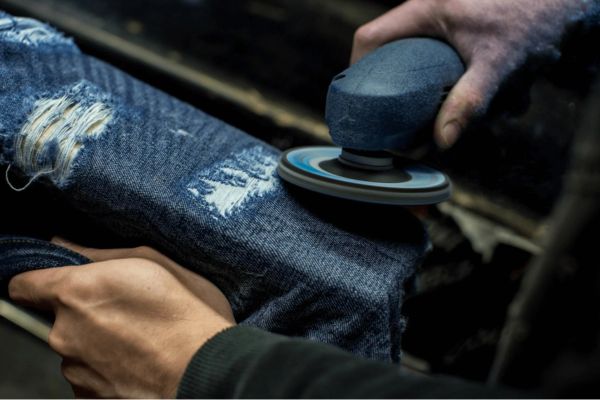Jeans are more than just a wardrobe staple; they are a fashion statement that has endured decades of ever-changing trends. Behind the scenes of every pair of stylish denim pants lies a fascinating process that contributes to their unique appearance the art of jeans grinding. In this article, we’ll delve into the world of jeans grinding machines, exploring their evolution, functionality, and the impact they have on the denim industry.
This revolutionary equipment greatly improves the efficiency and effectiveness of the jeans grinding process, very suitable for the age of fashionable dress.
Table of Contents
What is Jeans Grinding Machine?

A jeans grinding machine is a specialized piece of equipment used in the denim manufacturing process. It is employed to create various distressed or worn-out effects on denim fabric, giving jeans a unique and fashionable appearance. The process involves using abrasive materials to wear down or abrade the fabric selectively, creating patterns, textures, and faded areas.
Jeans, with their universal appeal, have become synonymous with casual and trendy fashion. The process of jeans grinding plays a pivotal role in enhancing the rugged, worn-in look that many denim enthusiasts covet. Let’s unravel the story behind these crucial steps in denim production.
Steps of Jeans Grinding Process
The process of jeans grinding involves meticulous steps that transform a regular pair of denim into a fashion statement. From the initial roughing to the final touches, every stage contributes to the overall aesthetic appeal of the jeans.

Here’s a basic overview of how a jeans grinding machine works:
- Preparation:
- Denim panels or garments are loaded onto the machine, and the operator ensures they are securely positioned for the grinding process.
- Adjustments:
- The machine settings are adjusted based on the desired outcome. This includes selecting the type and grit of abrasive materials, adjusting the pressure, and setting the speed of the grinding wheel.
- Grinding Process:
- The machine features a grinding wheel or abrasive belt that rotates at high speed. This abrasive surface comes into contact with the denim, selectively removing layers of fabric.
- Operators guide the denim through the machine, controlling the areas to are distressed. This manual control allows for a customized and unique appearance.
- Distressing Patterns:
- The grinding machine can create various distressing patterns, including whiskers (lines near the crotch area), fades (lightened areas), and abrasions (worn-out patches).
- The operator’s skill is crucial in achieving the desired look, as they can control the depth and intensity of the distressing.
- Quality Control:
- After the grinding process, the denim undergoes a quality check to ensure that the desired distressed effects are achieved and that the fabric remains structurally sound.
- Washing and Finishing:
- Following the grinding process, the denim may undergo washing and finishing steps to enhance the distressed appearance and ensure a comfortable feel.
Jeans grinding machines play a vital role in the fashion industry by enabling manufacturers to produce distressed denim garments that are popular among consumers. The process adds a vintage or worn-in look to jeans, contributing to the diverse range of styles available in the market.
Main Feature of Jeans Grinding Machine
- The daily output is 100-140 jeans/h, the daily output is 1000-1400 jeans/ day.
- Mold standardization: The hardware is a modular actuator that is used to change the processes. Software is set with different process parameters to guide prompt operation and quickly transform processing technology.
- Comfortable operating environment: It’s set with such functions as dust collection and air purification, which can improve the operating environment and reduce production pollution to the environment.
- Multi-purpose: Lifting, cat’s whiskers, grinding, and other processing technologies can be realized on a machine.
FAQs
Can jeans grinding be done at home without special equipment?
Absolutely! While industrial machines offer precision, creative individuals can experiment with DIY jeans grinding using simple tools like sandpaper and pumice stones.
Are there health risks associated with working with a jeans grinding machine?
Safety is paramount. Protective gear, including goggles and masks, should be worn. Adequate ventilation is also essential to minimize health risks.
What is the average cost of a high-quality jeans grinding machine?
Prices vary based on features and capacity. On average, a reliable jeans grinding machine can range from $5,000 to $20,000.
Can any type of denim be used for grinding, or are there specific requirements?
While most denim types can undergo grinding, softer denim tends to yield better results. Experimenting with different denim fabrics can lead to unique textures.
How long does the jeans grinding process typically take?
The duration varies based on factors like machine efficiency and desired results. On-average, it can take anywhere from 30 minutes to a few hours.
Conclusion
In conclusion, jeans grinding is an art form that adds depth and character to the world of denim fashion. As we celebrate the unique textures and styles created through this process, let’s acknowledge the craftsmanship and skill embedded in each pair of jeans.

Mahedi Hasan working as an Executive (Fabric Marketing) at Pengnuo Group. Graduated with B.Sc. in Textile Engineering. Before was a Top Rated content writer at Upwork, and Level 02 Seller at Fiverr, Level 02 Publisher at Ezoic. Very passionate about content writing, SEO practice, and fashion website designing. Highly Experienced fashion writer for the last 4+ years. Have extensive 7 years of experience in the wholesale clothing business.
